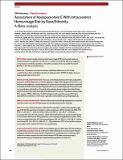Por favor, use este identificador para citar o enlazar a este item:
http://hdl.handle.net/10261/203800COMPARTIR / EXPORTAR:
 SHARE SHARE
 CORE
BASE CORE
BASE
|
|
| Visualizar otros formatos: MARC | Dublin Core | RDF | ORE | MODS | METS | DIDL | DATACITE | |

| Título: | Association of Apolipoprotein E With Intracerebral Hemorrhage Risk by Race/Ethnicity |
Autor: | Marini, Sandro; Crawford, Katherine; Morotti, Andrea; Lee, Myung J.; Pezzini, Alessandro; Moomaw, Charles J.; Flaherty, Matthew L.; Montaner, Joan CSIC ORCID; Roquer, Jaume; Jiménez-Conde, Jordi; Giralt-Steinhauer, Eva; Elosua, Roberto; Cuadrado-Godia, Elisa; Soriano-Tárraga, Carolina; Slowik, Agnieszka; Jagiella, Jeremiasz M.; Pera, Joanna; Urbanik, Andrzej; Pichler, Alexander; Hansen, Björn M.; McCauley, Jacob L.; Tirschwell, David L.; Selim, Magdy; Brown, Devin L.; Silliman, Scott L.; Worrall, Bradford B.; Meschia, James F.; Kidwell, Chelsea S.; Testai, Fernando D.; Kittner, Steven J.; Schmidt, Helena; Enzinger, Christian; Deary, Ian J.; Rannikmae, Kistiina; Samarasekera, Neshika; Salman, Rustam Al-Shahi; Sudlow, Catherine L.; Klijn, Catharina J. M.; van Nieuwenhuizen, Koen M.; Fernández-Cadenas, Israel; Delgado, Pilar CSIC ORCID; Norrving, Bo; Lindgren, Arne; Goldstein, Joshua N.; Viswanathan, Anand; Greenberg, Steven M.; Falcone, Guido J.; Biffi, Alessandro; Langefeld, C. D.; Woo, Daniel; Rosand, Jonathan; Anderson, Christopher D. | Fecha de publicación: | 6-feb-2019 | Editor: | American Medical Association | Citación: | JAMA Neurology 76(4): 480-491 (2019) | Resumen: | [Importance] Genetic studies of intracerebral hemorrhage (ICH) have focused mainly on white participants, but genetic risk may vary or could be concealed by differing nongenetic coexposures in nonwhite populations. Transethnic analysis of risk may clarify the role of genetics in ICH risk across populations. [Objective] To evaluate associations between established differences in ICH risk by race/ethnicity and the variability in the risks of apolipoprotein E (APOE) ε4 alleles, the most potent genetic risk factor for ICH. [Design, Setting, and Participants] This case-control study of primary ICH meta-analyzed the association of APOE allele status on ICH risk, applying a 2-stage clustering approach based on race/ethnicity and stratified by a contributing study. A propensity score analysis was used to model the association of APOE with the burden of hypertension across race/ethnic groups. Primary ICH cases and controls were collected from 3 hospital- and population-based studies in the United States and 8 in European sites in the International Stroke Genetic Consortium. Participants were enrolled from January 1, 1999, to December 31, 2017. Participants with secondary causes of ICH were excluded from enrollment. Controls were regionally matched within each participating study. [Main Outcomes and Measures] Clinical variables were systematically obtained from structured interviews within each site. APOE genotype was centrally determined for all studies. [Results] In total, 13 124 participants (7153 [54.5%] male with a median [interquartile range] age of 66 [56-76] years) were included. In white participants, APOE ε2 (odds ratio [OR], 1.49; 95% CI, 1.24-1.80; P < .001) and APOE ε4 (OR, 1.51; 95% CI, 1.23-1.85; P < .001) were associated with lobar ICH risk; however, within self-identified Hispanic and black participants, no associations were found. After propensity score matching for hypertension burden, APOE ε4 was associated with lobar ICH risk among Hispanic (OR, 1.14; 95% CI, 1.03-1.28; P = .01) but not in black (OR, 1.02; 95% CI, 0.98-1.07; P = .25) participants. APOE ε2 and ε4 did not show an association with nonlobar ICH risk in any race/ethnicity. [Conclusions and Relevance] APOE ε4 and ε2 alleles appear to affect lobar ICH risk variably by race/ethnicity, associations that are confirmed in white individuals but can be shown in Hispanic individuals only when the excess burden of hypertension is propensity score–matched; further studies are needed to explore the interactions between APOE alleles and environmental exposures that vary by race/ethnicity in representative populations at risk for ICH. |
Versión del editor: | http://dx.doi.org/10.1001/jamaneurol.2018.4519 | URI: | http://hdl.handle.net/10261/203800 | DOI: | 10.1001/jamaneurol.2018.4519 | ISSN: | 2168-6149 | E-ISSN: | 2168-6157 |
| Aparece en las colecciones: | (IBIS) Artículos |
Ficheros en este ítem:
| Fichero | Descripción | Tamaño | Formato | |
|---|---|---|---|---|
| risk_raceEthnicity.pdf | 544,86 kB | Adobe PDF |  Visualizar/Abrir |
CORE Recommender
PubMed Central
Citations
26
checked on 11-abr-2024
SCOPUSTM
Citations
41
checked on 23-abr-2024
WEB OF SCIENCETM
Citations
37
checked on 24-feb-2024
Page view(s)
213
checked on 24-abr-2024
Download(s)
152
checked on 24-abr-2024

